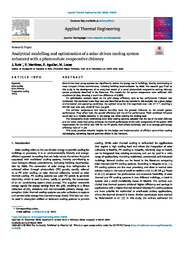Por favor, use este identificador para citar o enlazar este ítem:
https://hdl.handle.net/11000/35397Registro completo de metadatos
| Campo DC | Valor | Lengua/Idioma |
|---|---|---|
| dc.contributor.author | Ruiz Ramírez, Javier | - |
| dc.contributor.author | Martínez, Pedro Juan | - |
| dc.contributor.author | Aguilar-Valero, Francisco Javier | - |
| dc.contributor.author | Lucas Miralles, Manuel | - |
| dc.contributor.other | Departamentos de la UMH::Ingeniería Mecánica y Energía | es_ES |
| dc.date.accessioned | 2025-01-28T13:42:16Z | - |
| dc.date.available | 2025-01-28T13:42:16Z | - |
| dc.date.created | 2024 | - |
| dc.identifier.citation | Applied Thermal Engineering | es_ES |
| dc.identifier.issn | 1873-5606 | - |
| dc.identifier.issn | 1359-4311 | - |
| dc.identifier.uri | https://hdl.handle.net/11000/35397 | - |
| dc.description.abstract | Solar-driven heat pump systems can significantly reduce the energy use in buildings, thereby contributing to meet Europe’s climate commitments, including building decarbonisation by 2050. The research gap filled by this study is the development of an analytical model of a novel photovoltaic evaporative cooling chimney system previously described in the literature. The models for the system components were validated with experimental data, showing a maximum difference of 5.83%. An optimisation analysis based on the grid energy efficiency ratio as key performance indicator was conducted. The condenser water flow rate was identified as the key variable in this analysis. For a given design environmental and operating conditions, the optimal value for this magnitude was 1.05 m h−1, enabling a 3.8 kW load with only 44.33 W from the grid. The ambient temperature and relative humidity have the greatest influence on the overall system performance. They affect both, the panels’ efficiency and the chiller performance. Their combined influence could lead to a 10.86% reduction in the energy use while meeting the cooling load. The comparative study considering other solar cooling systems, assessed that the use of the solar chimney and the water–water heat pump enhances the overall performance of the main components of the system: 53% improvement for the chiller and 10% for the PV panels. Both effects combined, lead to an average grid energy efficiency ratio of 11.58. This study provides valuable insights for the design and implementation of efficient solar-driven cooling technologies, advancing beyond previous efforts in the literature. | es_ES |
| dc.format | application/pdf | es_ES |
| dc.format.extent | 13 | es_ES |
| dc.language.iso | eng | es_ES |
| dc.publisher | Elsevier | es_ES |
| dc.relation.ispartofseries | 245 | es_ES |
| dc.rights | info:eu-repo/semantics/openAccess | es_ES |
| dc.rights | Attribution-NonCommercial-NoDerivatives 4.0 Internacional | * |
| dc.rights.uri | http://creativecommons.org/licenses/by-nc-nd/4.0/ | * |
| dc.subject | Solar cooling | es_ES |
| dc.subject | Solar chimney | es_ES |
| dc.subject | Evaporative cooling | es_ES |
| dc.subject | HVAC | es_ES |
| dc.subject.other | CDU::6 - Ciencias aplicadas::62 - Ingeniería. Tecnología::621 - Ingeniería mecánica en general. Tecnología nuclear. Electrotecnia. Maquinaria | es_ES |
| dc.title | Analytical modelling and optimisation of a solar-driven cooling system enhanced with a photovoltaic evaporative chimney | es_ES |
| dc.type | info:eu-repo/semantics/article | es_ES |
| dc.relation.publisherversion | https://doi.org/10.1016/j.applthermaleng.2024.122878 | es_ES |

Ver/Abrir:
2024 ATE 245.pdf
2,63 MB
Adobe PDF
Compartir:
 La licencia se describe como: Atribución-NonComercial-NoDerivada 4.0 Internacional.
La licencia se describe como: Atribución-NonComercial-NoDerivada 4.0 Internacional.
.png)